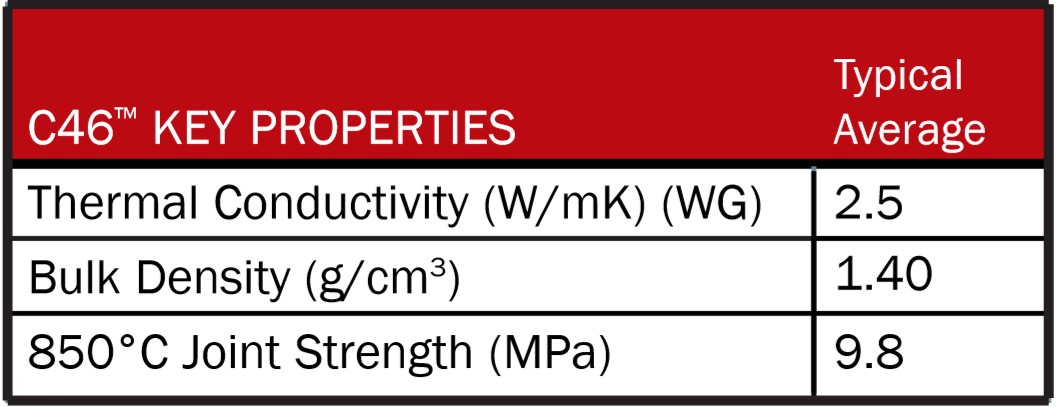DESCRIPTION
UCAR C46™ Cement is a single-component carbonaceous heat setting cement developed specifically as a mortar for use between carbon or graphite structural shapes. C46™ is used extensively in blast furnaces, cupolas, ferroalloy furnaces, phosphorus furnaces, runout troughs and other metallurgical applications. It thermally cures to form a strong carbonaceous bond between the cemented shapes.
 PACKAGING
PACKAGING
Grade C-46 Cement is supplied in 22.7 Kg (50 pound) pails and 68.1 Kg (150 pound) drums.
STORAGE
Cover cement and store in cool place when not in use. C-46 Cement will not deteriorate with age. However, it is recommended that the cement be used within two years after receipt to prevent settling or segregation.
PREPARATION FOR USE
C-46 Cement can be applied at ambient temperatures above freezing. For ease of application, however, the cement should be warmed to room temperature (approximately 21°C/70° F). Avoid overheating. Freezing and thawing will not harm the cement.
The container should be kept tightly closed and only opened prior to use. The cement must be thoroughly stirred in the container just prior to use. Occasional working of the cement with the trowel during use will retain trowelling consistency. If left standing for over an hour a thorough stirring once again is recommended. A large paint stirring paddle driven by 12.7 mm (1/2 inch) electric drill will conveniently mix a container of cement within a few minutes. It is important to agitate the entire contents. A metal rod can be used to loosen any solids that have settled to the bottom of the container during prolonged storage.
Addition of extra liquid (water) is normally not required if cement is thoroughly mixed. However, due to variation in temperature, atmospheric condition, and size of the powder component, it may be necessary to add additional liquid. Up to 600 ML (20 fl. oz.) maybe added to each container of cement to achieve the proper consistency for trowelling. Since excessive thinning of the cement reduces the strength of the cemented joint, do not exceed this guideline.
SURFACE PREPARATION
The surfaces to be cemented should be clean, dry, and dust free. Nominal surfaces should be slightly roughened by sandblasting or other suitable methods. Preferably the carbon or graphite should not be below 16° C (60° F). Joint thickness of more than 3.2 mm (1/8 inch) should be avoided. If joints up to 12.7 mm (½ inch) are to be filled, the cement should be mixed with graphite particles of a through-8-on20 mesh or with UCAR® Grade RP-4 Ramming Paste.
METHOD OF APPLYING
Apply cement to the work area with a flat serrated trowel or other suitable tool. Coat both joining surfaces to be cemented, working the cement well into each surface. After both surfaces are coated, add a little cement to the center of one of the coated surfaces to make a "crown." When the surfaces are pressed together, cement will flow from the center to the edges, thereby filling out the joint. Scrape off any excess cement after the joint is tightly closed.
Joint thickness of more than 3.2 mm (1/8 inch) should be avoided. If larger voids need to be filled then use the following guideline:
Size of Void:
0 mm to 5 mm (1/8 inch) – Use cement.
6 mm to 11 mm (1/2 inch) – Use 50/50 mixture of cement and carbonaceous ram such as UCAR RP-4, RP-10 or RP-20.
12 mm+ - Saw pieces of carbon brick to fit void plus cement.
CURING THE CEMENTED JOINT
With large carbon masses, such as furnace hearths and walls, the heat from the metallurgical process will normally cure C-46 Cement properly, thus eliminating the need for pre-curing. For other applications where components are cemented and then transported to furnace, the cement must be pre-cured before placing in service. To cure the cement, heat the cemented carbon or graphite shapes to 90° C (194° F) and hold at this temperature for four hours followed by 16 hours at 150° C (302° F). Curing temperatures below 90° C (194° F) result in longer set-up times. Too rapid heating causes the cement to exude from the joint before it sets up. The parts must not be moved after the pre-curing operation has begun. With proper pre-curing, a strong carbonaceous bond is developed between the carbon or graphite articles cemented. The fabricated structure is then ready for operation at higher temperatures which will carbonize the joint and complete the curing.
NOTE: A neutral or reducing atmosphere must be maintained at temperatures above 350° C (662° F).
CEMENT CLEAN UP
Water can be used to remove the fresh, uncured cement from tools and equipment.

















